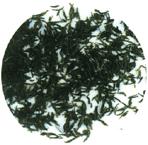1) special purple tea


特种紫茶
1.
Based on the animal experiments of 1991, we contrasted and analysed the content of blood pressure epressing active substances in the steamed tea and dried green tea which were processed from the special purple tea and Yunkang 10 in summer and autumn.
在1991年动物实验的基础上,对比分析了特种紫茶和云抗10号(对照)夏秋两季的蒸青、烘青茶中降压活性物质含量。
3) special UV light


特种紫外光
4) special-typed jasmine tea


特种茉莉花茶
1.
In this paper, started with the connotation of special-typed jasmine tea, the aroma formation and releasa of jasmine, and how mechanism of the raw tea absorbed the jasmine aroma, and change of chemical components and major influenced factors in the processing of jasmine tea were summarized.
本文从特种茉莉花茶的内涵入手,对茉莉花香气形成及吐香机理、茶坯吸香机理、加工过程中化学成分及主要影响因子以及特种茉莉花茶加工方式、窨制工艺技术、加工新方法等方面作了综述。
6) purple bud-tea


紫芽茶
1.
Research on biochemical components of purple bud-tea and development of health beverage containing them;
紫芽茶生化成分及其保健饮料的研究与开发
补充资料:顾渚紫笋茶

顾渚紫笋茶
顾渚,表明茶的产地是浙江的顾渚山。紫笋,因其色近于“紫”而形似“笋”得名,是历史悠久的司品贡茶,许多文人都曾吟诗作赋,称赞紫笋茶。唐代张文测道:“凤辇寻春半醉围,傈娥进水御帘开,牡丹花笑金钿动,传奏吴兴紫笋来”。
顾渚紫笋茶产于浙江省湖州市长兴县水口乡顾渚山一带,属绿茶类。因鲜茶芽叶微紫,嫩叶背卷似笋壳,故称。长兴县位于浙西北太湖之滨,南、北、西三面环山,东临太湖。境内有大小峰300余座,全县地处亚热带季风区,年均气温15.6℃,年降水量1600毫米左右,山区早晚云雾弥漫,土壤以黄、红壤和石沙土为主。茶树大部分种于山坞,当地称之为“界”。以西坞界、竹坞界、方坞界、高坞界等地种植最多。
品质特点:色泽翠绿,银毫明显,香蕴兰蕙之清,味甘醇而鲜爽;茶汤清澈明亮,叶底细嫩成朵。该茶被誉为“青翠芳馨,嗅之醉人,啜之赏心”。
说明:补充资料仅用于学习参考,请勿用于其它任何用途。